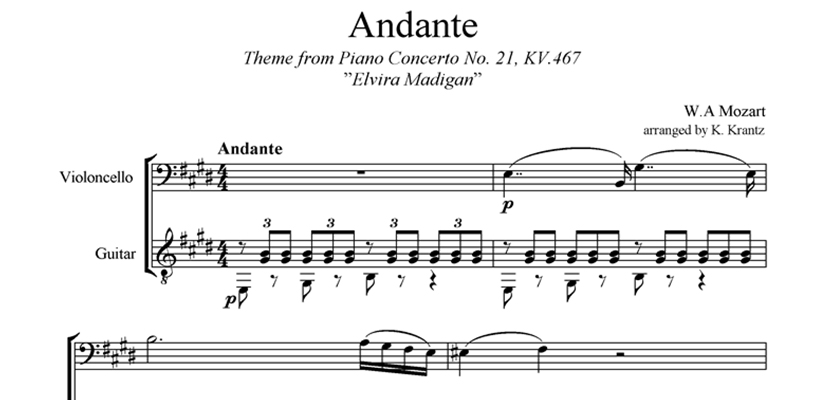
Mozart was a dab hand at the piano. Which is putting it mildly. A veritable child prodigy, by the age of five he was already performing for royalty. And by the time he died – at just 35 – he’d written 600 works including his Piano Concerto 21 shown above.
I mention all this because more than 200 years later Mozart’s music has something to teach us as presenters and public speakers. He knew how to captivate an audience with high notes and low notes. Fast sections and slower, more reflective sections. Louder bits and quieter bits. In short, he scored his compositions in such a way that made them captivating. And I’d argue that you should score your presentations to make them captivating.
Far too many of the presentations I’ve had the misfortune of sitting through wash over me. Not because the content is dull (although it may be) but because the delivery is dull and as a consequence the content, however important, fails to register.
“Blah, blah, blah…
Nobody uses these exact words, of course. But they do use words that when spoken by the same voice, at the same pace and the same tone end up sounding so samey they may as well be.
“…blah, blah, blah.
The net effect of which is to send the audience to sleep. So how can we turn our presentations from unintended lullabies into stirring sonatas?
[product sku=”wpid=21″]
TEMPO
Well let’s start with tempo. You’ll see the word “andante” appears above the bar at the beginning of the sheet music at the top of this post. This notation of Italian origin is an instruction that the movement or passage should be played at a moderately slow tempo. If the whole concerto was to be played at the same tempo it’d sound much less impressive. It’s the juxtaposition of different tempos that make each stand out and contribute to the overall effect. And so it is with presentations. What bits of your presentation are best delivered allegro – that is fast? And which sections might best be delivered adagio – slowly?
VOLUME
Back to that sheet music you’ll see the letter “p” appears under a couple of notes. This means that the note should be played piano or softly. Two ps together as in pp means the note should be played pianissimo or very softly. It seems counterintuitive but if you want your audience to take notice of a really important point, saying it more quietly than your usual presentational volume (p or pp in musical terms) forces them to listen more carefully and helps reinforce the point. Although not if you’re too quiet – ppp!
At the opposite end of the dynamic range are the effs – f, ff and fff. F stands for forte or loud. FF for fortissimo or very loud. And FFF for fortississimo meaning very, very loud. I’d avoid fff altogether as it can seem really rude and shouty unless done for special effect, in which case it’s probably best to forewarn the audience or, at the very least, explain immediately after the very, very loud passage why it was so. And even ff should be used sparingly as it’s tiresome to listen to permanently loud speakers.
The knack is to vary the volume in a pleasant sounding and naturalistic way just as we do automatically in conversation. Think of your presentation coming to a crescendo – another musical term that means increasing or, literally, growing. Build to a major point or a call to action.
REST
Look carefully at the sheet music above and you’ll see what looks like a fat or bold hyphen at the end. This is what’s called a rest (actually it’s a half rest but let’s not get too technical – this is presentation skills not piano grade 8). A rest mark tells a musician to pause for a period of time to let the previous note die away. To echo into the distance. To be savoured to the very last decibel. And so you should pause for effect in your presentations. Carrying on before the audience has properly understood and appreciated your previous point is to cheapen that point. A tip here. A short pause for the audience can seem like an eternity for us presenters – especially if we’re nervous in which case silence can really spook us. So in order not to under do the pauses count to five in your head in one thousand chunks before moving on.
“One thousand. Two thousand. Three thousand. Four thousand. Five thousand.”
In summary, the human voice is a musical instrument. So play it like one. And if you feel the audience may be getting bored listening to the same old instrument playing the same old song can you change the instrument (if not the song)? By that I mean can you change the presenter? Most presentations tend to have just one voice (you) but can you recruit co-presenters and double-head or even triple-head your next speech? The simple expedient of a change of voice can keep an audience attentive for longer.
Forgive me for a final foray into this musical metaphor. Make sure your presentations are well orchestrated. Be a maestro. Just like Mozart. Aim for a bravura performance.
This post was first published as a podcast (complete with extracts from Mozart’s Piano Concerto 21) in ACM Training’s Five Minute Masterclass series. You can listen to the original there or below.
[powerpress]
